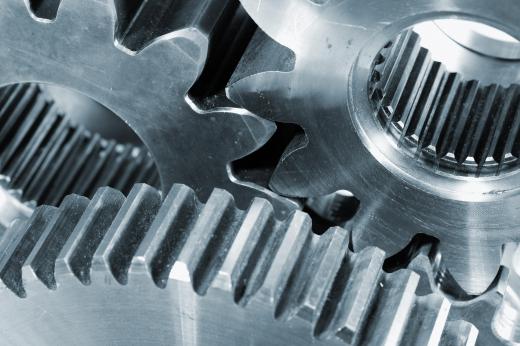A hobbing machine is a milling variant used to cut sprockets, gears, and splined parts using a specialist cutting tool known as a hob. The hob is a cylindrical cutting tool that features a series of helical rows of teeth. The hobbing machine features two spindles, one of which holds the work piece and the other the hob. Both spindles rotate at a set ratio while the hob is advanced into the workpiece to cut the teeth. Cutting toothed parts on a hobbing machine is a cheap yet accurate method of production of a wide range of products including worm gears, ratchets, involute gears, and helical gears.
Hobbing machines are similar in operation to conventional milling machines but for the specialized cutting tools used. These tools are known as hobs and are used exclusively for the hobbing process. Cylindrical in cross section, the hob features progressive rows of helical cutting teeth. The hob is grooved or fluted from top to bottom at regular intervals giving the tool a distinctive hand grenade appearance. These flutes serve to reduce cutting friction and aid in chip removal during cutting. The pitch and profile of the hob teeth depend on the desired end result although all follow the same basic design.

The construction of a hobbing machine is similar to that of a conventional milling machine and features a pair of rotating spindles, one for the workpiece and one for the hob. These spindles are place at an opposed angle to each other depending on the type of piece being produced. If, for example, a spur gear is being cut, the hob spindle angle will be equal to the gear's eventual helix angle. The relationship between the two spindles' rotational speeds is dictated by the tooth pitch of the finished product. For instance, a gear with 40 teeth will be machined at a 40:1 rotational ratio.
The hobbing process involves advancing the hob into the rotating workpiece until the desired tooth depth has been achieved. Up to five gears may be cut at one pass, and several separate gears may be stacked in the workpiece spindle and cut at the same time. Very large workpieces are typically gashed prior to hobbing. Gashing involves rough cutting the workpiece on a universal milling machine before it is finished on a hobbing machine. Hobbing is a very cost effective method of accurately cutting a wide variety of toothed products including helical gears, splines, worm gears, sprockets, and involute and cycloid gears.
